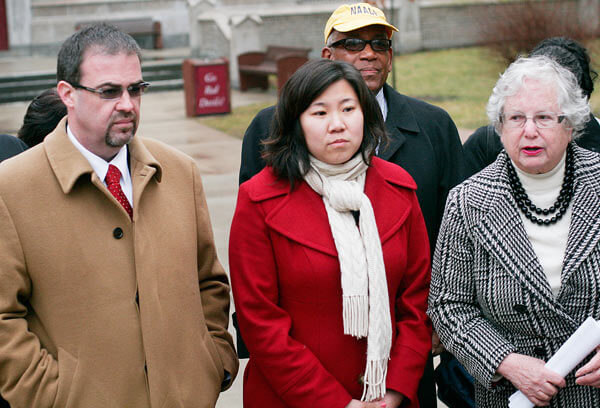By Joe Anuta
Elected officials and members of the teachers union protested the mayor’s plan to close Flushing HS Friday, a plan Mayor Michael Bloomberg said will get rid of bad teachers immediately instead of letting them linger in the struggling institution.
“Flushing HS is beginning to turn itself around,” said state Sen. Toby Stavisky (D-Whitestone), who chairs the Senate Education Committee.
She cited the graduation rates for the last three years in a row: 54 percent, 59 percent and 60 percent as her proof.
“The trend is there,” she said. “We don’t need additional layers of educational bureaucracy.”
Several teachers were on hand to tout the recent efforts of the school to pare down class sizes and increase staffing levels, changes needed to be made after Flushing HS was listed as one of the worst-performing in the state in January 2010.
That was the year the state Department of Education published a list of 57 schools around the state that it deemed “persistently low-achieving.”
But the fact that Flushing High was in the bottom 5 percent of the state’s schools meant it was eligible for state and federal funding to help correct its course. Specifically, the school was up for grants from State Fiscal Stabilization and federal School Improvement Grant funding.
As a stipulation for receiving the federal funds, Flushing HS, like the other 33 low-achieving schools in the city, had to follow one of four plans for reform stipulated by the state — the most drastic of which is called the “turnaround” model in which the school is closed and the students are shipped elsewhere, and the least drastic known as the “transformation” model.
Flushing HS was assigned the transformation plan, which involved the smaller class sizes and extra help the teachers mentioned Friday while outside the school with other lawmakers and representatives from the United Federation of Teachers.
Dermot Smyth, of the UFT, said Flushing HS just needs more time to keep on this course.
But time is exactly what the mayor said students at persistently low-achieving schools do not have when he gave his State of the City address in January.
A contingent of receiving federal money is to have a teacher evaluation system in place, something that needs to be negotiated between the state and the teachers’ union.
After the two sides were locked in an impasse over the evaluations, Bloomberg outlined a drastic method to get rid of poorly rated teachers in the 33 low-achieving schools in the city.
Instead of continuing on the transformation path, Bloomberg proposed to institute the “turnaround” model at all 33 schools. That model involves getting rid of half the teachers and replacing them with more effective ones who will be identified by a special commission. They would still qualify the schools for federal aid since it falls under another of the state’s four pathways for reform.
“We’re not going to wait around while ineffective teachers remain in those schools,” Bloomberg said in January, speaking at Morris HS in the Bronx. “Under this process, the best teachers stay; the least effective go. And now, that is exactly what will happen.”
A tentative agreement was reached last week that would unlock $700 million in federal money, and according to the crowd gathered at Flushing HS Friday, eliminate the need to switch to the “turnaround” model.
Yet Bloomberg said in a recent statement that the agreement does not change his plan to halve the staff at Flushing HS, which means teachers there are wondering if they will be given the ax or not, according to one at the rally.
The issue will be put to a vote at an upcoming vote of the Panel for Education Policy.
Reach reporter Joe Anuta by e-mail at januta@cnglocal.com or by phone at 718-260-4566.



































